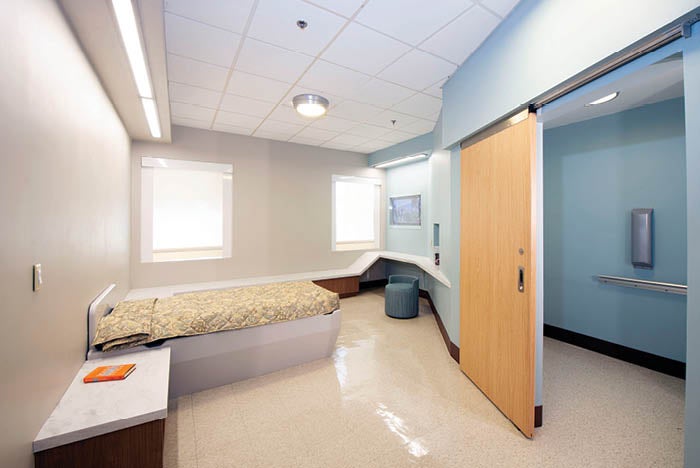Patients, staff differ on design opinions

A mock-up patient room in a VA behavioral health facility was designed with the goal of meeting nine patient-centered objectives.
Image by VA Photo, Scott R. Snell
Patients and staff responded differently to a mock-up of a mental and behavioral health unit patient room in a recent study. “Evaluation of a Mental and Behavioral Health Patient Room Mockup at a VA Facility” measured the effectiveness of a mock-up design at a VA New Jersey Health Care System facility to meet nine patient-centered principles, including respecting privacy; facilitating communication, collaboration and trust; and empowering patients.
Designers of the single-patient room wanted to create a deinstitutionalized atmosphere and a restorative environment that empowers patients along their behavioral health wellness journey, while ensuring a safe environment.
The American with Disabilities Act-compliant room features a private bathroom painted in cool blue and surfaces resembling marble, with ligature-resistant, stainless-steel finishes and a sliding door. The bedroom itself was painted in a light gray with one accent wall in cool blue. A sloping shelf resembling wood spans one wall to create a chaise lounge at one end and levels into a desk at the opposite end. Two windows with an operable portion that opens up to 4 inches provides access to daylight and outdoor scents and sounds. The room also features durable sound-absorbing plaster to curb noise.
Through feedback surveys and listening sessions, the researchers were able to measure staff and patient response to the design. In each of the nine categories, staff measured the design more favorably than the patients. The researchers scored each response on a scale of one to seven, with seven being the most positive. A four or higher was considered positive on the scale.
For patients, averages ranged from a low score of 4.36 for “facilitates communication, collaboration and trust” to a high score of 5.03 for “provides adequate acoustical control.” On the staff side, “promotes staff and patient safety” was the lowest score with 4.79. The highest scoring factor was “empowers patients and patient control” with a 6.14. When averaging the room as a whole, patients ranked it 4.77. Staff scored it at 5.52.
In listening sessions the researchers identified the top three priorities patients and staff had in mind when evaluating the patient room: safety, deinstitutionalization and positive distraction/nature.
Going forward, the VA central office of construction and facilities management says it will consider feedback from the mock-up evaluation project for its revision to the VA behavioral health design guidelines.




